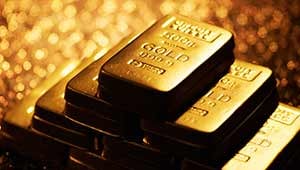Serving the New Silk Route
Dubai’s geographic location, increasingly at the centre of global trade, is a major asset in serving the gold industry. This includes rich logistics links and proximity both to India, the world’s largest market for gold and one of the biggest jewellery manufacturers, and to Africa, which remains a major source of mined gold. The emirate also is a major trading partner to China, which is the second largest market for gold and the world’s largest source of gold.
Winning Gold - Dubai’s growing role within the global gold trade
With its narrow labyrinthine alleyways, carved wooden roofs and waterfalls of glittering gold jewellery displayed in hundreds of shop windows, the Dubai Gold Souk hearkens back to the early 1900s, when it was founded.
At that time, encouraged by a tax-free and trade-friendly environment, a handful of merchants set up shop in an area of Dubai, not far from the creek. This creek and harbour on the Arabian Gulf facilitated the wooden dhow trade that supported the import and export of gold, as well as the merchants who came to buy and sell it. Since then, the souk (Arabic for ‘market’) has flourished, and now, more than 400 retail and wholesale shops operate in this bustling district, home to one of the largest retail gold markets in the world.
Until about 10 years ago, the Gold Souk was the primary justification for Dubai’s nickname “City of Gold”. Today, it earns the moniker as well because 1,200 tonnes of gold trades through Dubai, one-quarter of the global gold demand in 2011, according to the World Gold Council. In 2003, Dubai traded US$ 6 billion in gold; in 2011, it was US$ 56 billion; and in 2012, it was US$ 70 billion. Even taking into consideration gold’s phenomenal price rise over this period, Dubai has doubled the tonnage traded through the Emirate.
This global role for Dubai began in 2002, when DMCC was established to enhance commodity trade flows through the Emirate – today the Government Authority serves the entire gold value chain, from trading to refining to investing.
“We continually communicate with people operating in the gold trade here in Dubai and globally to provide new products and services that will add value to the trade,” says Gautam Sashittal, DMCC’s Chief Operating Officer. Examples of innovation include the Dubai Gold and Commodities Exchange (DGCX), DMCC Tradeflow, a trade finance product; regional gold options trading; a Shariah-compliant hedge fund product; and the Dubai Good Delivery Standard, the only international standard for 1kg gold bars of .995 purity.
The lustre of a gold cluster
A hundred years ago, Dubai created a thriving market for gold by providing the key ingredients to any market’s success: safety, security, rule of law, ease of doing business, a tax-free environment, good logistics, and proximity to large sources of both supply and demand.
Today, Dubai continues to offer these same factors to the gold trade, but on a larger, more sophisticated level. In Dubai, gold is physically traded, invested in, researched, vaulted, refined and manufactured into jewellery. No other gold centre offers such a complementary industry cluster effect, and all of this takes place within the DMCC Free Zone, a ‘city within a city’. Comprised of 66 high-rise office and residential towers, and commodity manufacturing facilities, it is home to over 8,000 businesses – two-thirds of which are in the commodities sector – with over 80,000 people working and living there.
Gold also is discussed and debated at DMCC as part of the annual Dubai Precious Metals Conference, set for April 6-7 this year. Last year 300 attendees discussed the state of the market; this year, more than 500 are expected for this global conference and the largest of its kind in the Middle East and North Africa.
Serving the ‘New Silk Route’
Dubai’s geographic location, increasingly at the centre of global trade, is a major asset in serving the gold industry. This includes rich logistics links and proximity both to India, the world’s largest market for gold and one of the biggest jewellery manufacturers, and to Africa, which remains a major source of mined gold. The emirate also is a major trading partner to China, which is the second largest market for gold and the world’s largest source of gold.
“Dubai is ideally situated at the transit point between Asia and Africa and Asia and the Middle East to facilitate the growing trade along this ‘New Silk Route’,” says Sashittal.
This is combined with massive, world-class logistics infrastructure that includes one of the world’s largest and fastest growing airlines, Emirates, which flies to most major cities in Africa, Asia, the Middle East, CIS countries and Europe; a leading global ports operator, DP World; the famous Jebel Ali Port, and efficient multimodal services linking sea, air and land.
Trading gold with confidence
For DMCC, which also supports the diamond, tea, and pearl trade by providing the appropriate physical, market, financial infrastructure and services, the goal is always to expand commodities trading by serving the needs of market participants. The Dubai Good Delivery (DGD) standard is one example. Now covering 14 refineries in 10 countries, the DGD filled a gap in the market and now is the definitive standard for 1kg gold bars of .995 purity, which are used primarily in jewellery making.
DMCC also is working with the OECD on the implementation of the OECD’s “Due Diligence Guidance on Responsible Supply Chains of Minerals from Conflict-Affected and High-Risk Areas” in the area of gold. DMCC has developed a standardised audit process that it is being implementing across its DGD-certified refineries.
“Trade and markets grow when participants have confidence in the products, in the other buys and sellers, in the regulatory environment and in the safety and security of the marketplace itself. This is what we offer in Dubai and at DMCC,” says Sashittal. “Here in Dubai, you can trade with confidence.”
